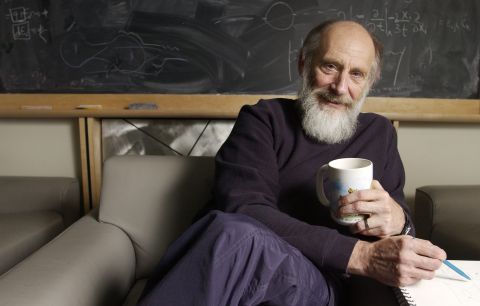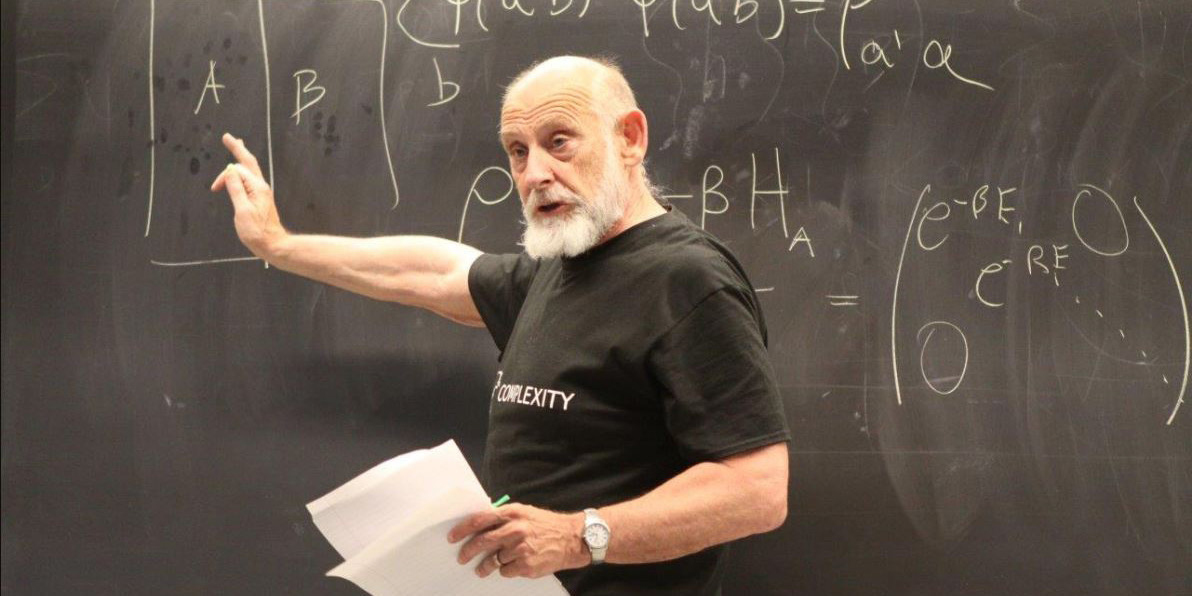Leonard Susskind, a physicist at Stanford University, is a founding father of string theory. Students recently had a Skype conversation with this 78 year old physics legend.
Leonard Susskind: "I consider teaching physics very important.” (Photo: Private collection)
You were a plumber before you studied physics. How old were you then?
“My father was a plumber and I worked with him from the age of 13. When I was 16 he got very ill, so I had to work a lot. We were not very well off. I worked during school and in the summer. It was very hard work and very different from being a plumber now. It was in the South Bronx and the buildings were very old and had lead pipes. It was tough, rough work and it made my father sick. I did it until I went to graduate school. That was in 1962.”
How did your family respond when you told them you wanted to study theoretical physics?
“Well, at first my father wasn’t happy. He wanted me to work in his business, but I said I wanted to be a physicist. He left school after fifth grade, but he was a very smart man. However, he didn’t know what a physicist was and mixed it up with a pharmacist. He said “You’re not going to work in a drugstore” and I said, “No, I mean what Einstein did”. The minute he heard Einstein, he said no more. He got very excited about it; he wanted me to be a physicist. It was a good experience.”
Did you party a lot when you were a student?
“Not a lot. By the time I became a physics student I was already married and had a child. I was also still working as a plumber, so did I party a lot? No I did not.”
What do you think of lectures? Can you learn physics from them?
“They’re fantastically good for learning physics. The lecturer learns a lot of physics. After my first few studies, just about everything I learned about physics came from teaching it. I don’t know if the students learned a lot, but I certainly did. So I consider teaching physics very important.”
Do the students learn from it?
“I think they learn from some lecturers and less from other lecturers. My students sometimes come back and tell me they learned a lot from me and the ones who didn’t learn much probably don’t come back. So my guess is that good physicists pretty much learn from themselves. The students at Stanford cooperate and learn together and that is clearly a good thing. But I think that it is sometimes good to sit and learn by yourself. But as I said, I never really learned a subject until I had to teach it.”
Do you think anyone could learn physics?
“I don’t know. I know some very smart people whose minds are simply not tuned to physics. I’m a reasonably smart person, but I can’t understand money, finance and economics. As soon as I start to learn about it my brain starts wandering. So I’m not sure my friend Feynman was right when he said anyone could learn physics. Different people have different kinds of minds. I like literature, I read a lot, but I cannot read poetry. Somehow I don’t get poetry. People are wired in different ways; genetic make-ups are different. So I don’t know if anyone could learn physics.”
Introducing string theory, you were one of the people who came with the idea that a particle could be seen as a string. How did you come to this conclusion?
“There were lots of people who were studying hadron physics by studying scattering amplitudes. It was called the S-matrix theory and a version of it had been constructed by Gabriele Veneziano. It was a combination of the mathematically clever fitting of constraints and a bit of experimentation. Then he wrote down a formula on the scattering amplitude of two particles. The formula gives the amplitude for particles ‘a’ and ‘b’ scattering into particle ‘b’ and ‘c’ as a function of the momentum of the initial and final particles. It was just a formula and it was called the Veneziano amplitude.
Then a friend of a friend showed it to me. I had the advantage of knowing a lot about elementary quantum mechanics and when I looked at it, I thought it looked familiar. It resembled the formula for the scattering of a photon with an atom in which the atom is just a harmonic oscillator with a nucleus connected to an electron by a spring. The photon is absorbed by the electron and is re-emitted. When the photon is absorbed, the spring starts vibrating and it vibrates until the photon is re-emitted. I sat down and calculated it, just for fun and to learn how scattering works. When I saw the Veneziano amplitude, maybe four months later, I saw that it was pretty similar to my formula. I got excited and tried to figure out how I could modify the spring to make it look more like the Veneziano amplitude. I made it a little more complicated by connecting the spring to another spring and it started to look more like the Veneziano amplitude. After a couple of weeks of playing with it, I realised that if you replaced the spring with an elastic string, you got the Veneziano amplitude. I got very excited and thought I was the only person in the world that knew this, but another physicist named Nambu also knew about it and we both published our papers at about the same time. While I was very disappointed that I wasn’t the only one that knew this, Nambu was a great hero of mine. To discover that I was doing work at the same level as Nambu was exhilarating.”
Do you still do research in string theory?
“Yes I do. I think about gravity and quantum mechanics, about the connections between gravity and quantum mechanics, entanglement, all those kinds of things. They all flow out of string theory. We have learned a great deal about gravity and its connection with quantum mechanics in the last 15-20 years. Even though they emerged from thinking about string theory, people don’t talk about strings so much now. They talk about entanglement, quantum information, q-bits, but I think they need to be embedded in a string theory context to be precise and convincing. String theory played a tremendously big role in mathematical rigour and providing real examples for studying. I don’t think we would have much confidence in what we’re doing if it wasn’t backed up by the string theory mathematics. Although I’m not much of a mathematician, I recognise the important stuff in the more rigorous work that went on.”
Do you think string theory is true?
“Well, we need to look at definitions. What do you mean by true? There is a very precise, rigorous mathematical theory called string theory. Mathematicians have won big prizes for studying aspects of it. It is a mathematical structure and it always has a property called supersymmetry, and it is always a theory in flat spacetime or in anti-de Sitter space.
If we use a very narrow definition of what we mean by string theory – that mathematically precise supersymmetric thing – it doesn’t describe the world we live in. The real world lives in some kind of de Sitter space and is not supersymmetric. So we know that we should not define string theory that narrowly. We know that string theory has quantum mechanics and gravity so the real question is how do you expand the definition? How can we make it a theory of the real world? I don’t know. What we do know is that it is a precise mathematical structure that has quantum mechanics and gravity and is consistent. That’s a big thing. But how we push it to de Sitter space and not being supersymmetric, we don’t know. I believe that anyone saying that string theory is true is just guessing that there is a version of it that we do not have now.”
You wrote a book called The Black Hole War, in which you disagree with Stephen Hawking on quantum mechanics and black holes. What did you disagree about?
“Stephen Hawking was a friend of mine, I respected him enormously and we had a good relationship. We had a ‘war’ of ideas, not a war of people. Stephen was convinced that black holes undermined, or destroyed, the idea of information conservation. The evolution of a quantum system is supposed to be unitary, which means that you can run it backwards. So if you know the present state of a closed system, a system that is not disrupted, you know its future and it’s past. According to Stephen, you cannot know the past because anything entering a black hole simply gets lost and cannot be reconstructed from the Hawking radiation which goes out. That basically violates the rules of quantum mechanics and of physics. I thought it had to be wrong, Stephen thought it had to be right. Almost everybody thought Stephen was right. The only other person I knew shared my views was Gerard ‘t Hooft, truly one of the greatest physicists of the 20th century.”
What is it like, being a theoretical physicist?
“I don’t sit at a desk all day. Sometimes I sit on my sofa with a piece of paper. But I also spend a lot of time walking around thinking and discussing with people. I’m only at my desk when I’m writing, for publishing for instance. I also spend time sitting in cafés and other places. Sleep is very good for physics. Sleeping during a lecture is a good thing. So I do many things that could be called doing physics. I get a lot of ideas while I’m walking around, sitting in cafés or even talking to somebody. But I think that many of my theoretical physicist friends probably do spend a lot of time at their desks.”
What problems in physics are you thinking about these days?
“I’m thinking about something that ‘t Hooft and I were interested in a while ago called the holographic principle. That’s the idea that a theory should be formulated at the boundary of a region of space. What I’m very interested in, is how simple aspects of gravity are represented on the holographic side. I’m also interested in the idea of another Dutch physicist called Erik Verlinde. His very interesting idea is that gravitational attraction is related to entropic forces. I think he’s on the right track, but I think it’s more related to complexity. The last two papers that I wrote were about gravitational attraction and its relationship to complexity so I’m still thinking about this.
I often think about how to explain some of the simple things I know about physics. Can we explain the gravitational attraction of objects through a holographic description in quantum mechanics? I’ve also been thinking about explaining gravity through this holographic idea. If you can’t explain the simplest things about gravity from the holographic description, you don’t have much of a theory. The simple things sometimes force you to think about more complicated mathematics, so you go and learn it. But I prefer simple explanations. I like it if I can explain things from elementary physics rather than through some advanced mathematics.”
This story was written by Silvester Borsboom and Lorena Hendrix for De Physicus, paper of the Delft study association of Applied Physics. You can read the original version here.
 (Photo: Linda Cicero / Stanford News Service)
(Photo: Linda Cicero / Stanford News Service)


Comments are closed.